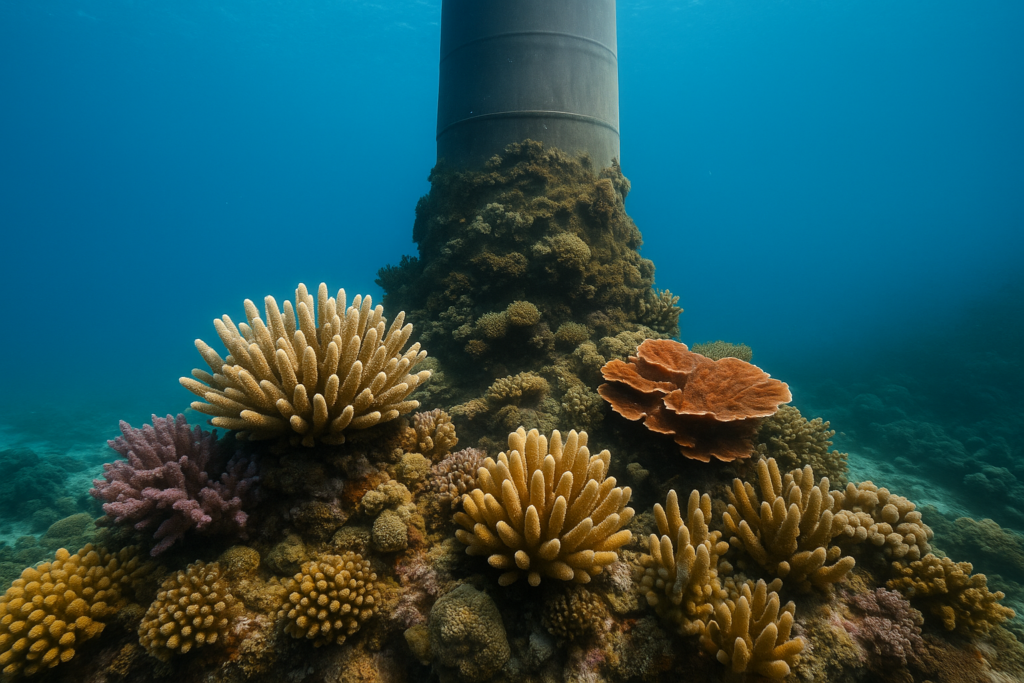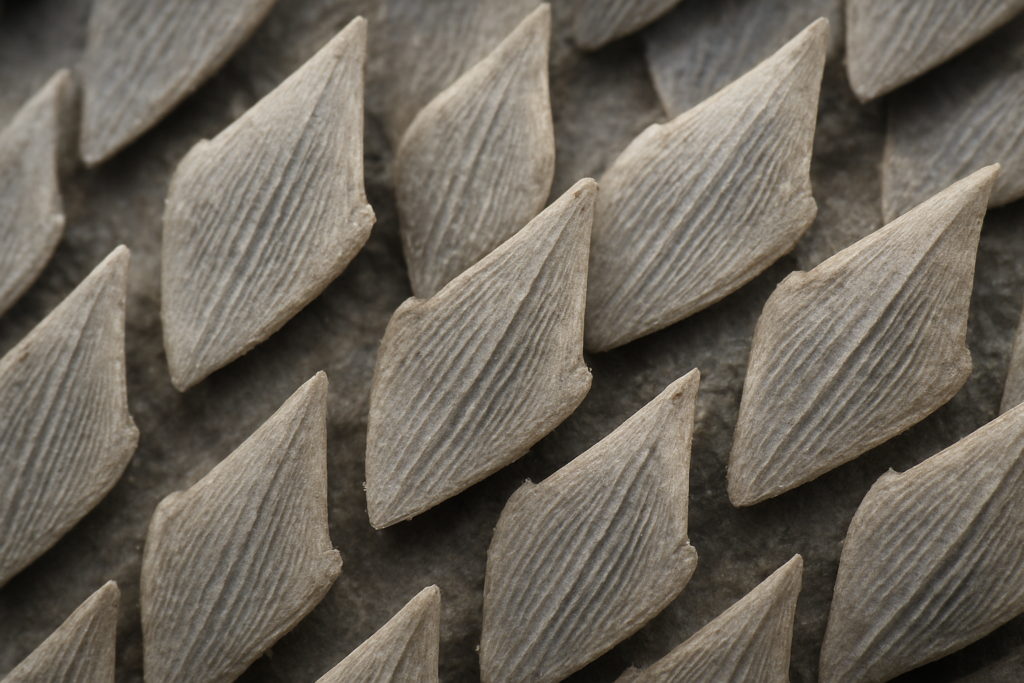The ocean has spent the last few billion years testing and refining its own engineering solutions.
Despite more available data than ever, its vastness remains a largely alien environment to humans. But the flora, fauna, and forces at play there likely hold the key to more resilient, efficient, and sustainable offshore development and operations.
What is Biomimicry?
Biomimicry – or biomimetics – is the process of studying nature’s structures, patterns, and systems, to inspire human innovation.
People have been doing this for a long time. Leonardo Da Vinci obsessively studied bird anatomy to better understand flight. George de Mestral conceptualised Velcro as he pulled sticky burrs from his dog’s coat. And Olympic swimmers remove all of their body hair to shave half a second from the record.
Unlike traditional engineering, which can be in opposition to natural forces, biomimetics embrace nature’s own tried-and-tested solutions. Organisms have evolved over eons to optimise efficiency, resilience, and adaptability, offering a blueprint for sustainable and high-performance technologies.

Why is biomimicry relevant in offshore wind farm development?
Many of the specific problems faced by offshore wind farm developments – structural integrity, efficiency, and environmental impact – can potentially be answered through the methods applied by natural marine ecosystems and organisms.
The world’s oceans are one of its final frontiers, still holding some of the most inaccessible landscapes and secrets of the planet. Through observation and study of these largely unknown ecosystems, we can better understand them; what works, and what doesn’t.
By adopting the techniques of marine species, and complementing (rather than opposing) natural forces and phenomena, we can optimise offshore renewable energy development and generation.
How can marine ecosystems influence offshore wind farm design?
Hydrodynamic efficiency: Humpback whales inspiring turbine design
Perhaps counterintuitively, as aerodynamics theory suggests instead that “straight and sharp” is better, humpback whales are natural masters of fluid dynamics.
Their unconventional pectoral fins feature tubercles – the small, rounded bumps that reduce draft, enhance lift, and make them so iconic, also allow for precise, energy-efficient movement through the water. This adaptation has redefined aerodynamic and hydrodynamic efficiency in various engineering fields already.
By integrating humpback whale-inspired tubercle designs, wind turbine blades can significantly reduce drag, delay stall onset, and increase overall efficiency. University-led research has already begun to show that whale-fin-inspired blades can significantly improve turbine power output, ensuring better operational outputs for offshore wind farms.
Countering biofouling: Sharks helping streamline turbine maintenance
Sharks have mastered the art of staying sleek and efficient in the ocean without accumulating unwanted hitchhikers.
Biofouling (the accumulation of marine organisms such as barnacles, algae, and mollusks on submerged structures) presents an inevitable operational challenge for offshore wind farms. Biological deposits increase hydrodynamic drag, reduce energy efficiency, and necessitate costly maintenance interventions. Traditional anti-fouling solutions, such as copper-based paints, introduce environmental risks by leaching biocides into the surrounding waters, that contribute to marine pollution.
Sharks’ skin, though, has micro-scale dermal denticles which disrupt the ability of biofouling organisms to attach themselves, even when moving slowly through the water. This principle has led to the development of biomimetic anti-fouling coatings, designed to emulate shark skin textures and passively inhibit marine growth.
Emerging research indicates that these shark-inspired coatings can reduce biofouling by over 80%, significantly lowering maintenance requirements and prolonging turbine longevity. As the offshore wind sector grows, incorporating bio-inspired surface engineering could lead to reduced operational expenditure and enhanced turbine performance, enabling improved long-term sustainability in both floating and fixed-bottom wind farms.

Image: 3d rendering of shark skin denticles
Self-healing: Sponges, starfish, and self-regenerating materials
Marine organisms such as sponges, starfish, and corals have evolved regenerative mechanisms that allow them to maintain structural integrity under harsh oceanic conditions.
Offshore wind turbines face constant mechanical stresses, extreme weather conditions, and exposure to corrosive salt water. Fatigue damage over time can escalate into structural failures requiring expensive repairs and equally costly downtime.
Sponges are able to repair tissue damage and fully reconstruct their silica-based skeletons; starfish can (famously) autonomously regenerate their limbs. Corals can also naturally restore their calcium carbonate frameworks, ensuring long-term resilience in dynamic marine environments. These biological processes have informed the development of self-healing polymer composites and concrete formulations for offshore wind applications.
Materials embedded with microencapsulated healing agents can seal “micro-cracks” upon exposure to seawater, preventing structural deterioration before failure occurs. The integration of these self-repairing materials into turbine foundations and support structures could enhance asset longevity, reduce O&M (operations and maintenance) costs, and improve overall lifecycle efficiency – all being key considerations as offshore wind farms extend into more remote and more challenging marine environments.
Seabed stability: Corals and mangroves shaping wind turbine foundations
Coral reefs and mangrove forests serve as nature’s first line of defence on many of the world’s coasts.
These complex ecosystems act as natural wave barriers, absorbing and dispersing energy before it’s able to reach the shore. Corals, with their robust and interwoven structures, anchor to the seabed and prevent sediment displacement, and protect shorelines by diverting up to 97% of wave energy. The dense root networks of the mangroves stabilise coastal zones, protecting them from rapid erosion.
Seabed erosion caused by disruptive currents around turbine foundations poses considerable challenges to offshore wind farm construction and maintenance. By mimicking the structural complexity of coastal vegetation, researchers are exploring reef-inspired turbine bases that not only prevent scouring, but also encourage marine life to thrive – improving both ecological and structural stability.
Energy storage: Jellyfish inspiring floating offshore wind
Jellyfish exhibit one of the most energy-efficient propulsion mechanisms in the oceans.
The increasing development of floating offshore wind turbines introduces new engineering challenges, particularly in maintaining structural stability, reducing mooring stress, and optimising energy storage solutions in dynamic ocean environments. Conventional floating platforms rely on rigid mooring systems, which are subject to extreme forces from waves and currents, increasing the likelihood of material fatigue over time.
Jellyfish, however, have evolved a highly efficient propulsion mechanism that enables them to traverse ocean currents with minimal energy expenditure. Their pulsation-based movement generates low-pressure vortex rings, which optimise thrust while reducing drag, allowing them to maintain mobility in fluctuating conditions with negligible energy loss.
This principle is now being explored for adaptive floating wind platforms, where biomimetic mooring and platform designs could dynamically adjust to wave-induced forces rather than resisting them outright.
Some experimental models integrate jellyfish-inspired flexible membranes and variable ballast systems, enabling platforms to optimise energy absorption and reduce mechanical strain. These designs may also facilitate dual energy harvesting, where floating wind turbines operate synergistically with wave energy conversion systems, increasing overall energy yield.
The environmental case for nature-inspired offshore wind farms
Wind energy has long been considered one of the cleanest methods of renewable energy production. And evidently, learning from nature’s own techniques of efficiency and protection can help further improve the developments of the future.
But one of the key concerns regarding offshore wind farms for environmentalists is the sometimes irreparable damage caused by turbine construction and operations. So, how can biomimetics help offshore wind farm developments to rebuild and foster healthy marine ecosystems?
- Regenerative materials require less direct maintenance.
- Biodegradable materials produce fewer waste products.
Coral reefs provide homes and safety to a huge portion of the ocean’s organisms; a healthy reef is teeming with life. You’ve likely heard how the Great Barrier Reef is “dying”, but it’s not alone: coral bleaching caused by human action and climate change is a global issue.
In the face of this ecological disaster, however, researchers are finding that the foundations of offshore wind turbines offer the unique conditions needed by corals to thrive. By cultivating and planting new, man-made reefs around the foundations of turbines, we can start foster new and rebuild existing marine ecosystems.
Biomimicry isn’t just great for wind turbine design and operations, it can also help us to start mending the damage already caused to natural habitats by human developments.
So, What’s Next?
The future of offshore wind will be shaped by nature-inspired engineering. Institutions like the Fraunhofer Institute and MIT’s Sea Grant Program are pioneering biomimetic turbine designs, but for widespread adoption regulatory frameworks need to evolve.
Establishing a shared and accepted standard for biodegradable materials, bio-integrated structures (the reefs we were talking about) and ecological impact monitoring is required to ensure we don’t continue to damage the ocean’s ecosystems in the pursuit of renewable energy.
Government funding initiatives, such as Horizon Europe’s Blue Economy Fund are already driving investment in bio-inspired offshore wind innovations. But, to build a truly sustainable energy future, policymakers and industry leaders must commit to biomimetic solutions today.
Nature-inspired, AI-powered – right now…
NeuWave’s AI-powered environmental analysis provides faster, smarter offshore wind site assessments – helping developers reduce risk, cut costs, and maximise sustainability. Discover how our cutting-edge platform can transform your next project.

